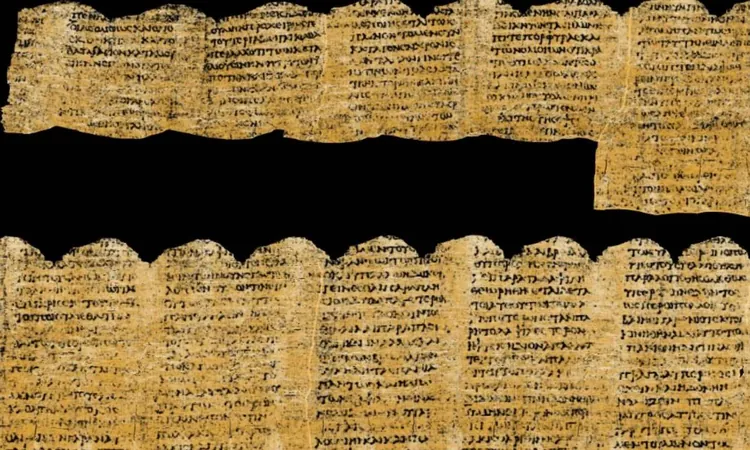
Unearthing Ancient Secrets: How AI and X-Rays Breathe Life into Charred Scrolls
2025-05-30
Author: Ming
In AD 79, the catastrophic eruption of Mount Vesuvius buried the Roman settlement of Herculaneum, leaving behind numerous ancient scrolls reduced to fragile, carbonized remnants. For centuries, these invaluable manuscripts were deemed irretrievable, as any attempt to unroll them resulted in catastrophic damage.
Technological Renaissance for Ancient Texts
However, a new wave of technological innovation brings hope. Pioneering efforts by researchers like Brent Seales at the University of Kentucky are paving the way to unlock these buried literary treasures. Seales has developed software that blends advanced imaging techniques with artificial intelligence, making it possible to read content once thought long lost.
The Hidden Library Awaits
Experts are now using powerful X-ray systems to scan these delicate scrolls without direct contact, revealing layers of compressed papyrus. By employing sophisticated AI algorithms, researchers can detect subtle differences between the carbon-based ink and the papyrus itself, a feat that was previously unimaginable.
Leading the Charge for Deciphering
International collaboration is key in this groundbreaking endeavor. Stephen Parsons spearheads a global competition dedicated to deciphering these scrolls. "We’re confident we will be able to read pretty much the whole scroll in its entirety," says Parsons, emphasizing the potential of machine learning models to unveil extensive texts previously hidden from view.
Virtual Unwrapping: A Breakthrough Method
The concept of 'virtual unwrapping' first gained momentum with the En-Gedi Scroll, an ancient Hebrew manuscript discovered decades ago. Researchers have adapted these techniques for the unique challenges posed by Herculaneum’s carbonized artifacts, allowing them to create detailed 3D maps of the scrolls while preserving their integrity.
Unlocking Lost Philosophies
So far, fragments uncovered from these scrolls hint at lost works from Epicurean philosophers, exploring ideas about pleasure and the simple joys of life. This discovery has sparked a renewed interest in ancient thoughts and cultural practices, guiding scholars towards a deeper understanding of historical beliefs.
Global Collaboration and Innovation
Unexpectedly, students have played an instrumental role in this breakthrough. Award-winning efforts in machine learning have uncovered previously invisible words and phrases in the scrolls. Seales acknowledges that collaborative funding and experimentation were critical in pushing these scientific boundaries.
A Transformation of Understanding
Scientists believe these advanced techniques could be the key to unlocking other damaged texts, often referred to as the 'invisible library.' These manuscripts, too fragile to handle, hold untold knowledge of antiquity. Scanning entire collections could drastically alter our understanding of the past and shed light on the daily lives and thoughts of ancient people.
AI's Expanding Role in Archaeology
The success achieved with the Herculaneum scrolls is prompting scholars and technologists to rethink how AI can aid in the study of cultural heritage. AI is not a replacement for human researchers; rather, it enhances their ability to identify patterns and nuances that are easily missed.
A Shared Human Connection
As researchers push the boundaries of what's possible, the excitement lies not just in the discoveries themselves, but in the enduring human desire to connect with ideas from millennia ago. These ancient writings can bridge the gap between then and now, igniting curiosity about our shared heritage.
The study of these scrolls, now published in *Nature*, is just the beginning. The implications stretch far beyond Herculaneum, as scholars anticipate that improved AI algorithms will aid in translating and deciphering texts across archaeological sites worldwide.



 Brasil (PT)
Brasil (PT)
 Canada (EN)
Canada (EN)
 Chile (ES)
Chile (ES)
 Česko (CS)
Česko (CS)
 대한민국 (KO)
대한민국 (KO)
 España (ES)
España (ES)
 France (FR)
France (FR)
 Hong Kong (EN)
Hong Kong (EN)
 Italia (IT)
Italia (IT)
 日本 (JA)
日本 (JA)
 Magyarország (HU)
Magyarország (HU)
 Norge (NO)
Norge (NO)
 Polska (PL)
Polska (PL)
 Schweiz (DE)
Schweiz (DE)
 Singapore (EN)
Singapore (EN)
 Sverige (SV)
Sverige (SV)
 Suomi (FI)
Suomi (FI)
 Türkiye (TR)
Türkiye (TR)
 الإمارات العربية المتحدة (AR)
الإمارات العربية المتحدة (AR)